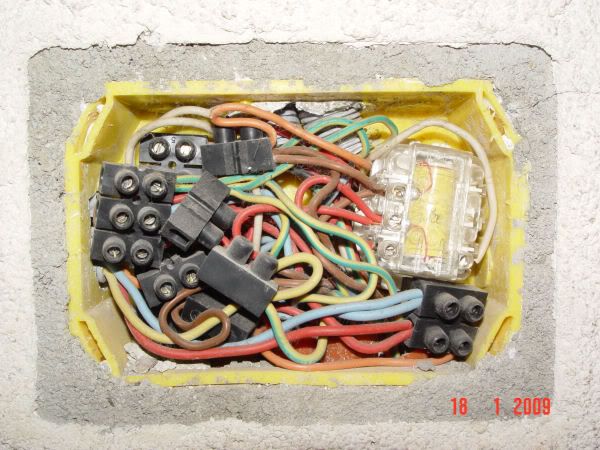Hi jonzjob, I MAY be able to help a bit, as I've just had the professional sparky doing the final wiring up of my 3 phase/single phase wiring in my cellar workshop (I did the grunt work like running conduit over the ceiling, fixing the dust filter, etc, he did the clever stuff, as req. by Swiss regs).
I took the opportunity to ask him questions & try to learn a bit more.
Your pic looks remarkably similar to some of my junction boxes (except that mine use push-in wire leaf spring attachments instead of screw terminals like yours (not used here very much now because screwing terminals takes too long apparently).
I think that like here, you do not have UK-type ring main wiring. I THINK this is because we (and you too I think) don't have fuses in each appliance plug. Therefore ring mains not allowed except in real industrial installations which are 380/415 V and where each socket outlet is protected by its own circuit breaker.
Here the wiring colours have changed to the current green/yellow (ALWAYS earth just as you say) and blue (ALWAYS negative). If the cable has 3 cores then the remaining colour is black which is ALWAYS positive. But if 5 core cables are used (as in my case, because the requirement is to spread the total loads approx. equally across all 3 phases) then the remaining 2 colours are grey and a sort of "reddish brown". These 2 are also ALWAYS positive.
Previously here (it changed sometime around the late 70's/early 80's apparently) the colours were Green = earth; Black = negative; and (3 core cable) Red = positive, (plus Yellow and Grey = positive if 5 core cable used). All power cable is 1.5mm up to 10 amps (lights too) and 2.5mm up to (I think) 16 amp (maybe 30 amp, I'm not sure).
A couple of caveats to all the above:
1. I MAY have got a couple of the smaller details wrong (my translation errors);
2. This is Switzerland, you're in France, so there may be some differences (after all, your plugs are different to mine!);
3. The above colour code does NOT cover wiring for lighting, which is anyway more complicated than in UK, especially if 2 way switches are involved!
Hope that may help you at least a little bit.
AES


































